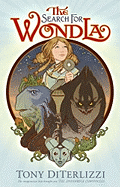
Tony DiTerlizzi (The Spiderwick Chronicles, with Holly Black) constructs a fantasy world that reveals truths about our 21st-century society. Imagine that you are 12 years old and have never left the confines of your home. Now imagine that you were raised in an underground Sanctuary by a multi-limbed robot named Muthr and have never seen the sun, the sky (except in holograms), or another human being. Still, you are convinced that there is someone out there who is just like you. That is Eva Nine's plight. Surrounded by holograms and machines that fill her mind with facts, Eva Nine "just want[s] to have friends." She wants to search for people like her. People like the ones in the image she discovered of a child, adult and robot on "a small, thin item," which she calls "WondLa" because of the few letters still legible on it. Her opportunity arrives sooner than expected when an intruder breaks into the Sanctuary, forcing Eva to flee while Muthr stays behind to try and extinguish the fires he sets. Even though Muthr has been training Eva, with the aid of an Ominpod (a handheld device with a small eye-like opening), to survive on their planet's surface, nothing prepares Eva for what she discovers there.
DiTerlizzi creates a tantalizing paradox: a world of creatures who seem at once primitive yet extraordinarily advanced. The intruder who devastates Eva's Sanctuary, a towering Dorcean named Besteel, flies in a glider and carries a sonic boomrod (a futuristic stun gun), yet thinks like a single-minded beast in search of prey. An armored behemoth named Otto (which Eva's Omnipod identifies as a kind of "tardigrade or water bear") communicates with her telepathically. And a blue-hued rabbit-like Caerulean who comes to Eva's aid speaks a seemingly nonsensical language then hands her a transcoder that acts as a translator. His words may be the wisest of all. He introduces himself as Rovender Kitt, "an old creature in a new world." The heroine replies, "I am Eva Nine... a new creature in an old world." The author threads other lyrical symmetries throughout the narrative: at the novel's start, Eva ponders the delicate construct of a piece of moss, which leads her to ask, "What is its purpose? What is my purpose?" Much later, when she is captured for possible inclusion in Her Majesty's museum, the curator echoes her musings, "All organisms strive toward a common goal... to understand one of the universe's biggest mysteries: Why are we here?" Instead of going down the rabbit hole with Alice, we travel up to the surface with Eva. But the two share much in the sense of exploring a wonderland: here a blue Caerulean leads us through forests and the winding roads of an island city filled with captivating creatures--like Arius, the many-tentacled soothsayer who speaks in riddles ("I have siblings. Siblings that I know. Yet siblings that I hide from.... You have siblings. Siblings you don't know. Siblings you've been hidden from"). DiTerlizzi's illustrations manage to be both futuristic and deeply rooted in the moment—no small task. He brings the volume to a highly satisfying conclusion yet leaves enough unanswered questions (how did Eva and Muthr end up in the Sanctuary, and what happened to civilization as we know it?) for the remaining books in the planned trilogy.--Jennifer M. Brown

